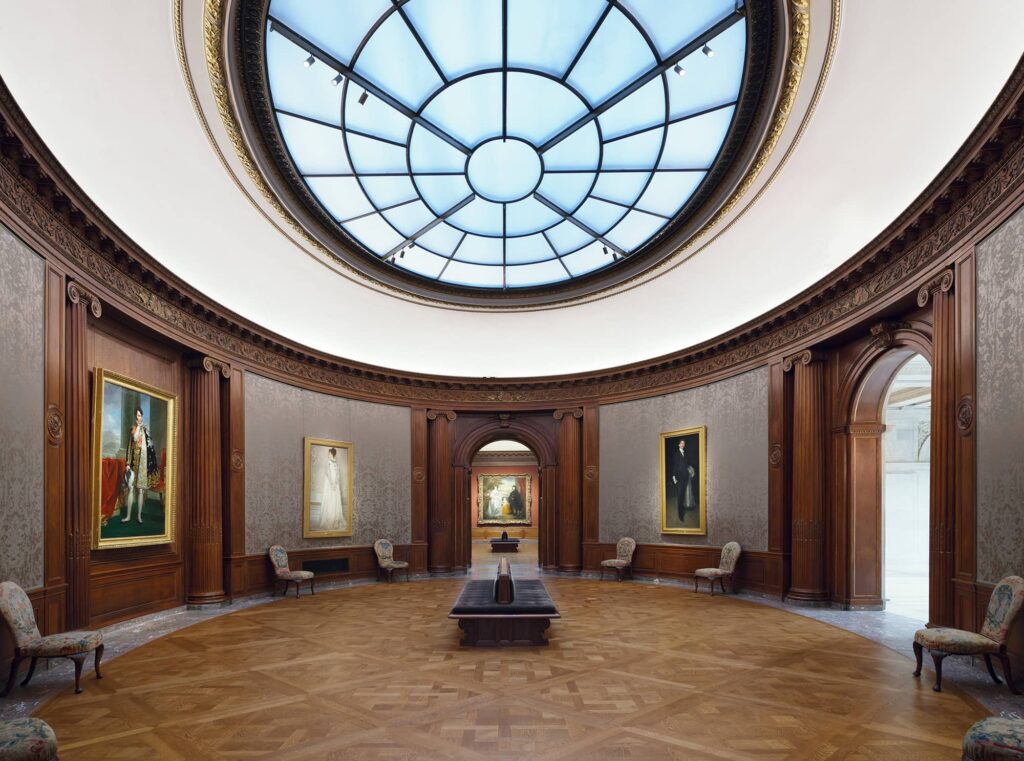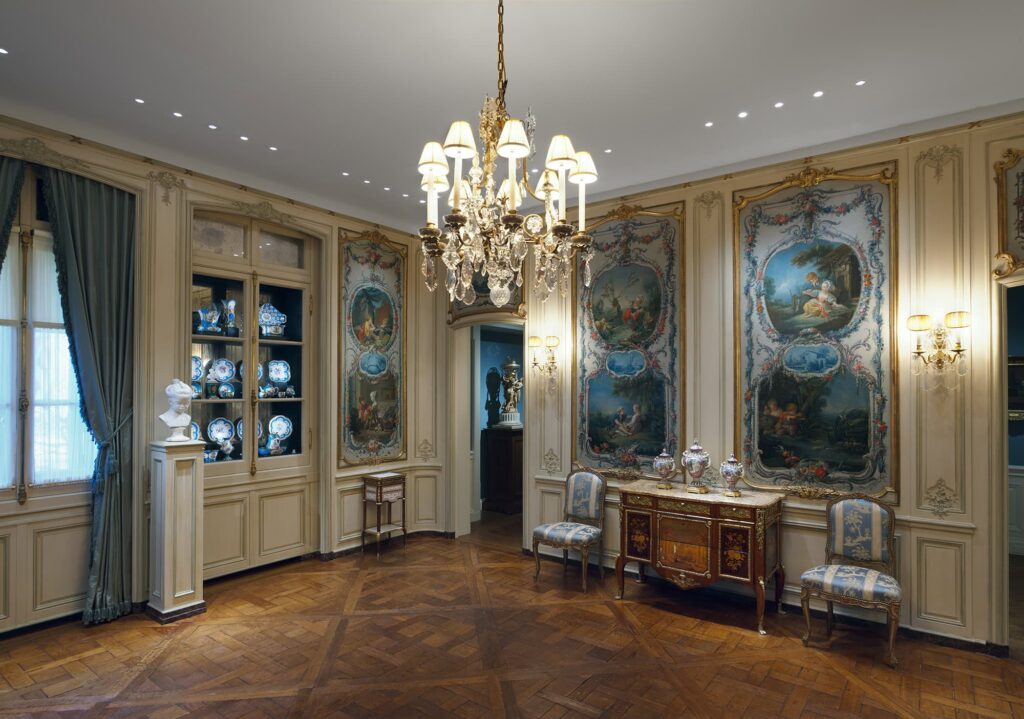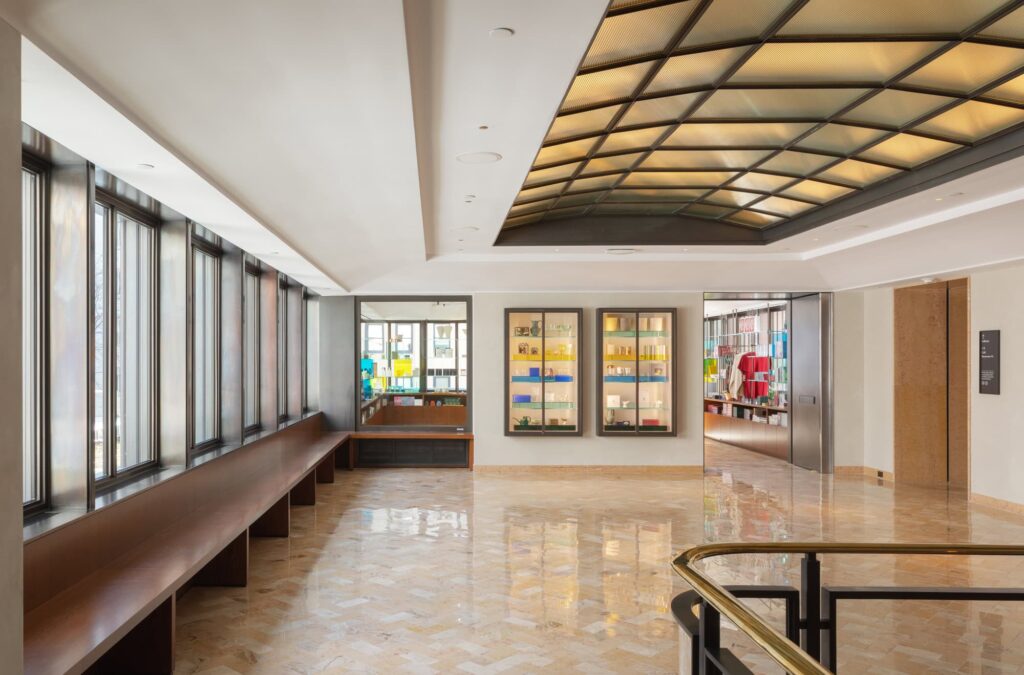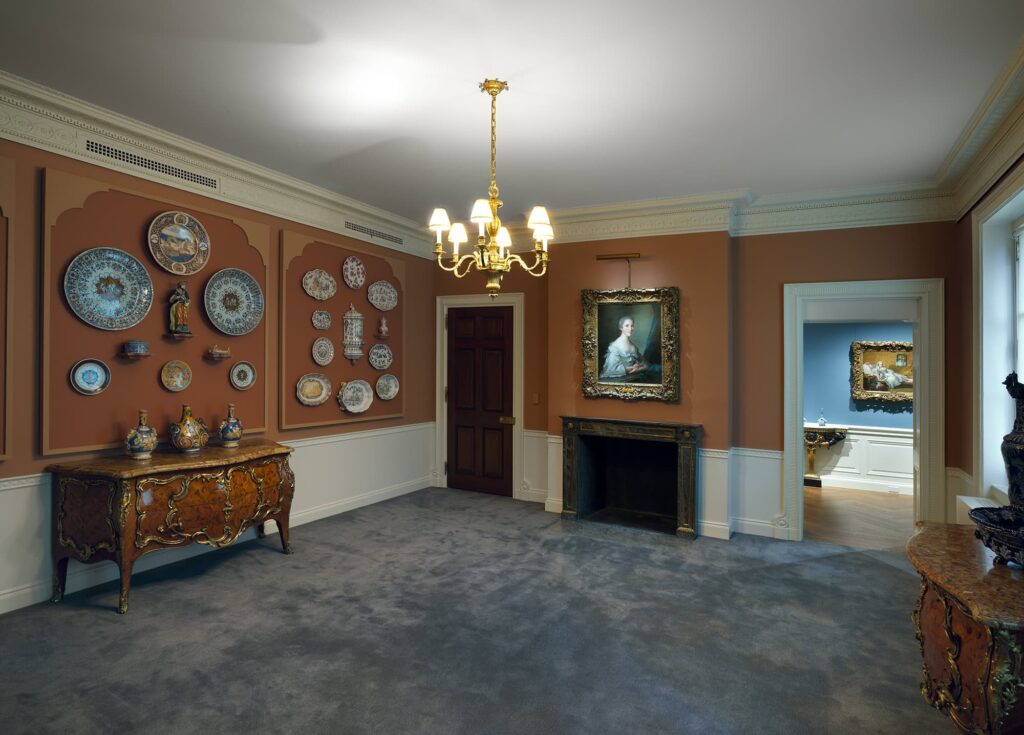Cover image: Fragonard Room, The Frick Collection, New York. Photo: Joseph Coscia, Jr.
On March 25th, I had the great privilege of previewing the newly renovated Frick Collection in advance of its April 17th public opening. As my readers probably know, I’m a huge fan of the Frick and have been avidly following its renovation since it was first announced. Everything I read suggested that it would be a success, but the reality of the refurbished museum still managed to exceed my expectations. Uncommon amounts of restraint, wisdom, and attention to detail were clearly involved, and the results are pretty spectacular.
A Refresher

The Frick Collection is an art museum in New York City’s Upper East Side. Originally the collection of Gilded Age tycoon Henry Clay Frick and further developed by his daughter Helen, it features fine and decorative arts (mainly but not exclusively European) from the early Renaissance through the turn of the 20th century.
The museum resides in Frick’s 1913 Beaux-Arts mansion, though both the collection and the building have been expanded several times already. Accordingly, the Frick doesn’t feel like most other art museums. While it’s definitely not an historic house museum like Biltmore or the Newport Mansions, it strongly preserves the ambiance of displaying art in a luxury domestic interior of the era. The Frick certainly hasn’t remained stagnant, but it has always managed to evolve while protecting its unique personality. I love the Frick because of its calm, sophisticated, and elegant approach to art history. I once called it “an oasis in New York”, and I continue to stand by that assessment.
The Frick has been closed since 2020 for a huge renovation that involved refurbishing the historic building and garden, upgrading systems like lighting and climate controls, increasing accessibility, converting the second floor into museum galleries, and building a tasteful addition. The entire project was led by architect Annabelle Selldorf, who has a deep love of the Frick and a strong history of sensitive renovations in historic structures. During its closure, the Frick temporarily set up in the former Whitney Museum building on Madison Avenue. I’ll fondly remember Frick Madison and its juxtaposition of historical art with modernist architecture, but it’s definitely good to be back in the mansion.
The New(ish) Experience

In many ways, the Frick hasn’t really changed. Yes, the renovation has produced very meaningful results, but they’re changes in quality and quantity, not character. There’s more to see, and the viewing experience has definitely improved, but the overall feeling is pretty much the same as ever. I felt like I was watching a higher resolution director’s cut of my favorite movie – the same great story and characters with better visuals and extras. Of all these improvements, general restoration of the interior and improvement of its systems are perhaps the most subtle, but they make a world of difference. The Frick wasn’t exactly shabby before, but it definitely looks fresher and more vibrant now (dare I even say more magical) without looking unnaturally new.
It’s actually a bit shocking how much better the art looks in this refreshed setting. Colors appear more vivid, details are easier to see, and each artwork seems to have a grander presence than before. The difference is like switching from regular resolution to HD. I initially thought the paintings had also been cleaned and restored, but Chief Conservator Joseph Godla told me that’s not the case. Instead, he says that the improved viewing experience is mostly due to the museum’s new lighting. This includes special new LED lights, the replacement of dingy old skylights, and shades to reduce glare by limiting natural light. I’m never doubt the power of good lighting again.
You can learn more about the lighting, historic restoration, and other aspects of the renovation in a series of videos produced by the Frick. They illuminate all the skill, thought, and care that went into every aspect of the project and highlight some of the modern-day artists and craftspeople who made it possible.
The First Floor

With one exception, the first-floor galleries haven’t experienced major curatorial changes. Bellini’s St. Francis in the Desert and Holbein’s Thomas More and Thomas Cromwell are all back in their old places in the Living Hall, the Whistlers still hang in the Oval Room (more permanently this time), and the West Gallery is still filled with masterpieces by the likes of Turner, Veronese, and Rembrandt.
However, there’s a lot fewer of them than before, since many artworks have found their way upstairs. Adding so much new exhibition space on the second floor means the museum can put fewer pieces in each gallery while displaying more artworks overall. I thought this made a particular difference in the West Gallery and adjacent Enamels Room, which used to be slightly overcrowded in my opinion.
The only major change on the first floor is the removal of the Boucher Room. This delightful installation of Rococo painted panels and French decorative arts has returned to the second-floor space (Mrs. Frick’s former boudoir) that it originally inhabited during the Fricks’ residence. A so-called Cabinet Gallery currently showing prints and drawings from the collection has taken its place downstairs.
The Second Floor

Like many Frick fans, I’ve always dreamed of ascending the mansion’s grand staircase. Finally, I’ve had the chance. Originally the family’s private rooms and later museum offices, the second floor has now been converted into about a dozen galleries. These include Renaissance religious paintings, portraits, Impressionism, 19th-century landscape paintings, porcelain, clocks, and coins/medals, some of which had previously been in storage. My favorite upstairs spaces were the ceramics gallery, the Walnut Room featuring portraits like the Comtesse d’Haussonville and Lady Hamilton as “Nature” amidst beautiful wood paneling, and the Boucher Room.
If there was any aspect of the renovation I worried I might not like, it was these upstairs galleries. I feared they might look bland and modern, but that isn’t the case. Smaller and less opulent than the rooms downstairs, they’re definitely a bit closer to traditional museum galleries, but original fireplaces and woodwork, richly-colored walls, and upholstered seating for visitors all help to maintain character and keep them from looking institutional.
While you’re upstairs, be sure to check out the whimsical murals on the hallway ceilings. They were painted by American artist Alden Twachtman and are original to the house.
Additions

Anyone who’s been having nightmares of an incongruous modern appendage attached to this beautiful old building can relax, because the new additions are fairly unobtrusive. Mainly on the east side of the structure, they’re not even noticeable from Fifth Avenue, and they don’t impact the visitor experience in the galleries. You’ll primarily encounter them on the first floor in the expanded reception hall and new special exhibition galleries; on the second floor, they include the gift shop, cafe, and a second reception hall. (The cafe won’t open right away, so don’t plan on getting a snack there just yet.) The special exhibition galleries are particularly significant, because the museum will no longer have to remove parts of the permanent collection to display temporary shows.
New or newly-adapted spaces also provide new education rooms, an underground auditorium, wheelchair-accessible ramps and elevators, improvements to the adjacent Frick Art Research Library, conservation studios and other non-public spaces, and more. These areas don’t pretend to be historic, but they do harmonize with the existing structure in color, materials, and overall aesthetic. They probably won’t seem any more noteworthy to future visitors than earlier additions seem to us today.
Details

As I’m sure is clear by now, I loved every aspect of the Frick Collection’s renovation and was delighted by my first visit. Regardless of whether you’re a longtime Frick fan or are just hearing about it for the first time, I highly recommend visiting once the museum officially reopens on April 17, 2025. I suggest allowing yourself plenty of time and walking through the whole building more than once, which worked well for me. There’s a surprising amount to absorb, and it’s best done gradually. I spend a little more than two hours there myself.
At least at first, it will be necessary to purchase timed tickets in advance. I’m not sure if this will be a permanent policy or if it’s only for the busy opening months. Visit the museum’s website to reserve and to get the most up-to-date information about hours and prices, keeping in mind that the Frick does not allow visitors under the age of 10. I know that seems harsh, but it makes sense in a museum that doesn’t place ropes or glass between visitors and fragile artworks.
In accordance with longstanding Frick practices, photography is not allowed in the galleries and artworks generally don’t have labels, but you can use the Bloomberg Connects app if you want to learn more about the artworks.
Thank you so much to the Frick Collection for inviting me to the press open house and allowing me to see the renovation before its public premiere! I was really honored to be included and will always remember this amazing experience.


